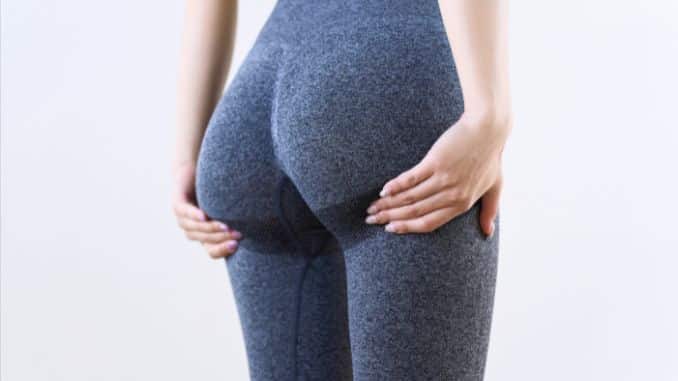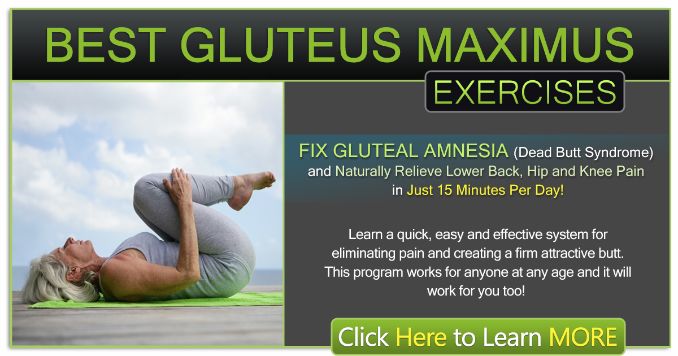Looking to get more out of your glute workouts without expensive equipment or gym memberships? Whether you’re aiming for a rounder booty, stronger hips, or simply want to fix that nagging knee pain — targeting your gluteus maximus the right way is the game-changer you’ve been missing.
Moreover, let’s break down exactly what your glute max does, why hip flexors matter, and how to grow your gluteus maximus using just your bodyweight — right from home.
But first… let’s dive straight into the step-by-step glute max exercises so you can get started today:
How To Do Each Exercise: Step-by-Step?
1. Prone Hip Extension
Targets: Gluteus Maximus, Glute Engagement, Hip Extension
Focus on the glute max and keep movement steady for better muscle activation.
- Lie down in good alignment, with your head, neck, back, hips, and ankles in line.
- Then, put your forehead in your hand or put a towel underneath your forehead.
- With your other hand, ensure that your shoulder is happy and healthy.
- Additionally, tighten your abdominal area, lift your thigh off the ground, and extend your leg.
- Moreover, focus on the gluteus maximus and then lower back down.
- Do this in a smooth and controlled movement, coming to the top and back down.
- You want to isolate your gluteus maximus with this exercise, so squeeze your glute as you lift and lower your leg.
2. Prone Hip Extension Progression
Targets: Gluteus Maximus, Hamstrings, Glute Engagement
This version adds more muscle growth [4] potential and helps correct weak glutes.
- Start in the same position, bend at your knee, lift your heel towards the ceiling, and lower back down.
- Additionally, again, isolate your glutes by squeezing your glutes throughout the exercise, and use the strength of your glutes to lift and lower your leg.
3. Prone Hip Extension with Resistive Band
Targets: Gluteus Maximus, Hip Stability, Muscle Imbalances
- Utilize a resistive band like a mini looped band and place it just above your knees.
- Moreover, this will give you some resistance, challenging that gluteus maximus a lot more.
- Get back into that starting position, lying on your stomach, head resting, spine and shoulder in a good position, and tightening your abdominal area.
What Does the Glute Max Do?
Moreover, the gluteus maximus [2] is the largest muscle in your body — and it’s not just for looks. Additionally, it powers your:
- Hip extension
- External rotation
- Pelvic stability
- Upright posture
Weak glutes? Without proper glute max exercises, you’re looking at a chain reaction of hip instability, back pain, and knee issues.
“The gluteus maximus isn’t just about aesthetics—it’s critical for hip extension, power output, and injury prevention. Underactive glutes often lead to compensation patterns that overload the low back and knees.”
— Dr. Kelly Starrett, DPT, founder of The Ready State and author of Becoming a Supple Leopard
Why Your Hip Flexors Matter?
Moreover, your hip flexors and glutes work like a seesaw. When one is tight or overactive, the other gets lazy — a common culprit in gluteal amnesia, characterized by poor glute activation.
Additionally, that’s why exercises like hip thrusts, Romanian deadlifts, and the split squat can be crucial for restoring balance between the front and back of the hips. These also support how to grow your gluteus maximus more efficiently.
Best Glute Exercises You Can Do At Home
No gym? No problem.
Additionally, here are additional glute max exercises you can pair with the routine above:
- Glute Bridge (feet hip width apart, squeeze your glutes at the top)
- Moreover, bulgarian Split Squat (great for glute medius [3] and glute minimus too!)
- Lateral Lunge (targets hip abductors and improves hip and pelvic stability)
- Single Leg RDL (balances muscle imbalances and builds the upper glutes)
Moreover, these bodyweight exercises target all three gluteal muscles [1]: gluteus maximus, gluteus medius, and gluteus minimus — for complete glute development and improved injury prevention. Also, perfect if you’re focused on how to grow your gluteus maximus naturally at home.
Bonus Tips for Maximum Glute Gains
- Always start with glute activation exercises before your main workout.
- Then, keep your torso forward and maintain a hip-width stance for better control.
- Use ankle weights or resistance bands for extra challenge.
- Maintain a full range of motion for greater muscle growth.
- Moreover, don’t forget about hip abduction and hip adductors – they stabilize your pelvis and balance your lower body.
Final Word
If you’ve been doing the same exercises and not seeing results, it’s time to switch things up. Additionally, these glute max exercises will also help tone those butt muscles, address hip instability, and build a strong foundation — starting today. Moreover, for anyone wondering how to grow their gluteus maximus without gym equipment, this guide is your go-to plan.
If you want to improve the activation, endurance, and strength of your gluteus maximus, click here to check out the Best Gluteus Maximus Exercises program.
FAQ’s
What is the main function of the gluteus maximus?
The gluteus maximus is the largest muscle in the body and plays a key role in hip extension, external rotation, and pelvic stability. Moreover, it’s essential for walking, running, climbing, and lifting. Strong glutes protect your lower back, improve posture, and boost overall athletic performance.
Why do I feel glute exercises in my lower back or hamstrings instead of my glutes?
If you’re not feeling your glute max working, you might be compensating due to weak glutes, tight hip flexors, or improper form. Try glute activation exercises like glute bridges or modified side plank positions before your workout to better engage the gluteal muscles.
Can I build strong glutes at home without weights?
Absolutely. Many of the best glute exercises can be done using just your body weight. Moreover, moves like glute bridges, lateral lunges, split squats, and prone hip extensions target the gluteus maximus, glute medius, and glute minimus effectively — especially when done with proper form and high glute engagement.


